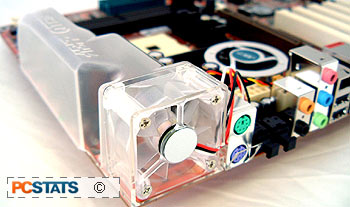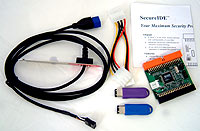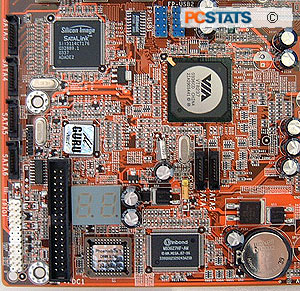
Ask any enthusiast about their
MOSFETs and you'll no doubt hear that they run hot. In fact it's common for
MOSFET to run 70+ degrees Celsius, creating a large hot spot in the PC. To help
deal with this situation, and hopefully decrease internal case temperatures,
ABIT equip the MAX3-series with proprietory OTES cooling system.
Essentially, this is a small
40x40m fan alongside the PS/2 ports which exhausts warm air out by the IO
connectors. A special plastic duct directs air over the bare MOSFETs before it
is blown out by the fan at the rear of the case.
With the system running, the
MOSFETs ran pretty cool, but as to whether this helps our overclocking or
stabilizes the voltage to the various devices attached to the motherboard I'm
not so sure. Is it peace of mind, or just a marketing tool? The jury is still
out on that question.
ABIT's Secure IDE
 Another neat feature
that ABIT has introduced with their MAX3 line of motherboards is the Secure IDE
hardware encryption for the HDD's.
Another neat feature
that ABIT has introduced with their MAX3 line of motherboards is the Secure IDE
hardware encryption for the HDD's.
What this is, is essentially a
small IDE-to-IDE circuit board adaptor that goes between the HDD and the IDE
cable. Built around an X-Wall LX-40 ASIC chip, the circuitry uses a 40-bit DES
(US Data Encryption Standard) to encrypt and decrypt the data as it is stored or
accessed from the hard drive. Secure IDE is compatible with all operating
systems since it is a hardware-level device, and uses zero CPU or memory
resources to do it's job. The device provides realtime encryption and can handle
transfers of up to 1.6Gb/s (200MB/s).
 On the actual Secure
IDE board there's a floppy drive power connector, Master/Slave settings as well
as a Ultra100/133 jumper indicator. The last nine pin connector is for the lock
which installs into an open expansion bracket in the back of the case. The cable
is 1m in length which should be long enough to reach the front of your PC. The
actual lock and key look exactly like an IEEE 1394a device, but are anything
but.
On the actual Secure
IDE board there's a floppy drive power connector, Master/Slave settings as well
as a Ultra100/133 jumper indicator. The last nine pin connector is for the lock
which installs into an open expansion bracket in the back of the case. The cable
is 1m in length which should be long enough to reach the front of your PC. The
actual lock and key look exactly like an IEEE 1394a device, but are anything
but.
Note that before you attach
the Secure IDE device to your hard drive you must back up your system because
you'll need to create a new partition and reinstall all your software. Once all
that is done you won't notice that you have the Secure IDE device hooked up to a
PC other than having to insert the key into the lock.
If someone steals a computer
without the security key in place, the motherboard will not even detect the hard
drive at POST.
The system is pretty powerful,
but the most obvious problem that may arise is if you lose both your keys, or
the Secure IDE device fails for any reason, you're pretty much out of luck. No
matter what we tried we could not retrieve any data from the HDD even if we
stoped using Secure IDE. So, this is a good tool, but not for everyone
certainly.
